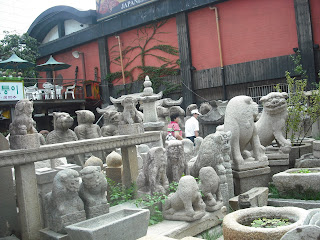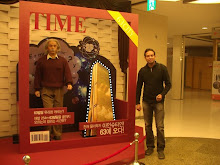











Insadong is one of the most favorite places in Seoul where I do not feel bore to go after several times. If I have time, I would like to go there alone or sometimes with my friends. It is very common for me to offer to my friends “How about to go to insadong for a walk”. Well, let’s start to know, “What the Inadong is”!!
Insadong is a dong, or neighborhood of the Jongno-gu district of the South Korean city of Seoul. The main street is Insadong-gil which is connected to a multitude of alleys that lead deeper into the district. At one time it was the largest market for antiques and artworks in Korea. In area, 12.7 hectares (31.4 acres), the district is bordered by Gwanhundong to the north, Nagwon-dong to the east, and Jongno 2-ga and Jeokseon-dong to the south, and Gongpyeong-dong to the west.
It was originally two towns whose names ended in the syllables "In" and "Sa". They were divided by a stream which ran along Insadong's current main street. The Insadong has a very long history. It began 500 years ago as an area of residence for government officials. During the early period of the Joseon Dynasty (1392–1897), the place belonged to Gwanin-bang and Gyeonpyeong-bang - bang was the name of an administrative unit during the time - of Hanseong (old name for the capital, Seoul). During the Japanese occupation, the wealthy Korean residents were forced to move and sell their belongings, at which point the site became an area of trading in antiques. After the end of the Korean War, the area became a focus of South Korea's artistic and cafe life. It was a popular destination among foreign visitors to South Korea during the 1960s, who called the area "Mary's Alley". It gained in popularity with international tourists during the 1988 Seoul Olympics.
It was originally two towns whose names ended in the syllables "In" and "Sa". They were divided by a stream which ran along Insadong's current main street. The Insadong has a very long history. It began 500 years ago as an area of residence for government officials. During the early period of the Joseon Dynasty (1392–1897), the place belonged to Gwanin-bang and Gyeonpyeong-bang - bang was the name of an administrative unit during the time - of Hanseong (old name for the capital, Seoul). During the Japanese occupation, the wealthy Korean residents were forced to move and sell their belongings, at which point the site became an area of trading in antiques. After the end of the Korean War, the area became a focus of South Korea's artistic and cafe life. It was a popular destination among foreign visitors to South Korea during the 1960s, who called the area "Mary's Alley". It gained in popularity with international tourists during the 1988 Seoul Olympics.
By the way, Insadong is very near from my dormitory. It takes only 10 minutes by bus and may be 30 minutes by walk. This is one of the reasons, why I like to stay in my dormitory when some of my friends have moved to very nice apartments. However, for those apartments, they had to pay big deposit money what I do not have. Such kind of deposit is very common in Korea for renting the apartment. Anyway, what I was telling about Insadong. This place is well known as a traditional street to both locals and foreigners and represents the “culture of the past and the present”. When I enter into Insadond Street, I feel that I am walking on the bally road, a street of Dhaka, Bangladesh, well known as Nattopara (Drama Street). I like to go there often as I was involved with some cultural activities. Sometimes I miss it but I can forget it when I walk on the Insadong Street. I get the same smell, same taste and same feeling when I am there.
Insadong-gil contains a mixture of historical and modern atmosphere and is a unique area that truly represents the culture history of the nation. The majority of the traditional buildings belonged to merchants and bureaucrats. Some larger residences, built for retired government officials during the Joseon period, can also be seen. Most of these older buildings are now used as restaurants or shops. Among the historically significant buildings located in the area are Unhyeongung mansion, Jogyesa- one of the most significant Korean Buddhist temples, and one of Korea’s oldest Presbyterian churches.
On the weekend, especially on Sunday, many locals and foreigners come to visit to Insadong. In one study showed that approximately 100,000 visitors come to Insadong on Sunday. Even though, on Sunday is very crowded, very difficult to move foot on the street but I like to go that day. It is more charming for me as I can hear different languages. I have always interest on different languages. If I get chance, then I do not miss to learn some sentences in different languages. I can remember when I was may be 10 years old, that time I memorize how to say “I love you” in twenty languages. But, now, almost I have forgotten because of lacking uses.
Insadong is the place where the people from different cultures can share their feeling and spread their opinions. For example, I went to Insadong yesterday (actually my target was to go to immigration office for fixing my Visa but, when I reached in front of the immigration office, I realized that I forgot to bring my passport. But I did not feel sad as Insadong is located near Immigration office) and when I was walking on the street , then I saw two guys looks European, were distributing some books. When I was passing by, then they offered me to look some books and asked me whether I am from India or not. Anyway, they are selling some books about “ Hore Krisna”. I have a little knowledge about “ Hore Krisna” Philosophy. I tried to share my opinion about "Hore Krisna Philosophy" with them. Through the conversation, I knew that they are from Russia and it's not for a long time, they started to follow the “ Hore Krisna” philosophy. I told them I would like to visit their temple. Actually, one of the main reasons to visit temple is, they offer really nice meal on Sunday… Yeammy Yeammy… . . After some spritual conversation with them I started to walk on my own way.
Insadong is the place, where you can see people of different ages are sitting with different kinds of traditional and antique things. It contains 40 percent of the nation’s antique shops and galleries as well as 90 percent of the traditional stationary shops. This place is famous for traditional tea. I tried may be only one time. It is common to see some artists are concentrated on making their things on the Insadong Street. There are daily calligraphy demonstrations and pansori performance. If someone like art, antique, nice tea and interested about different cultures and different people, then welcome to Insadong. Next time, let’s walk together on the Insadong Street and I am sure that you will get this feeling “People from Different Countries, We Are The Same”.










1 comment:
Great writing Br. Jamali, keep it up ~
Post a Comment